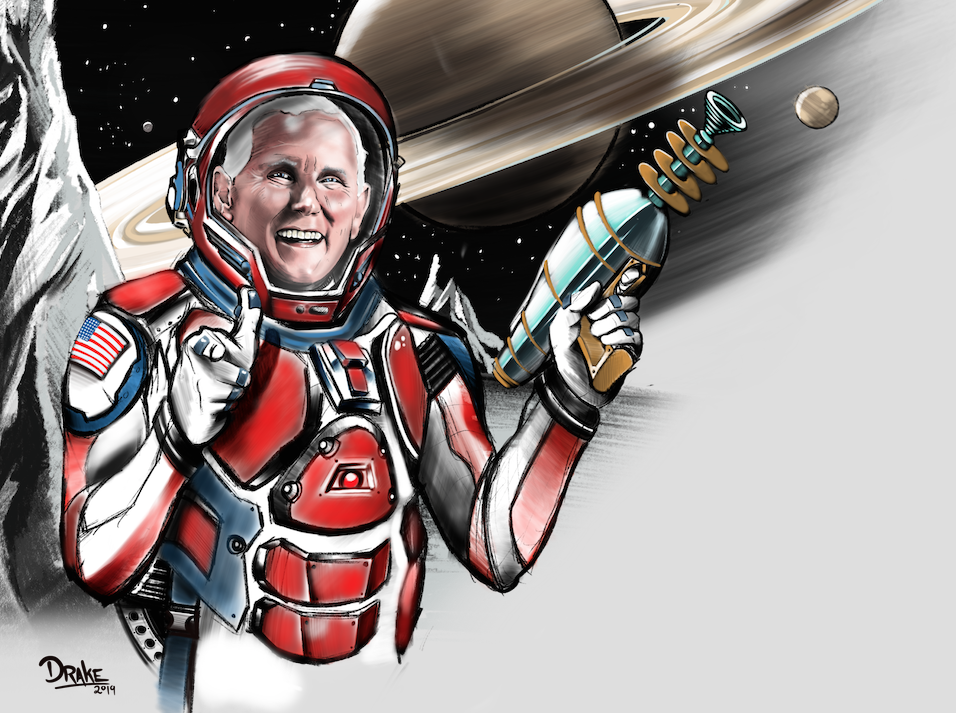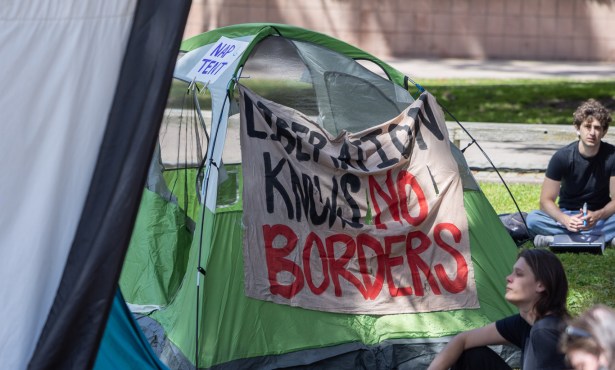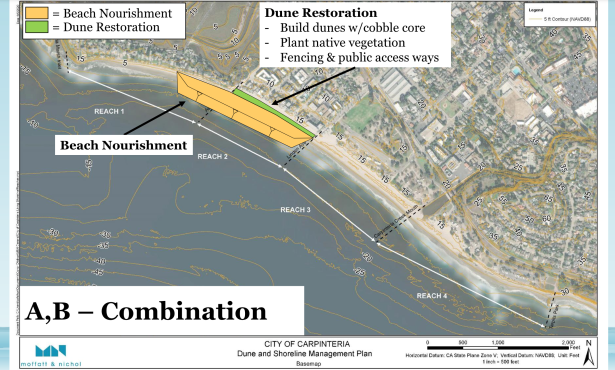Will Santa Barbara Get a Taste of Space Force Pork?
Pence Visit Confirms Vandenberg Remains in Running for New U.S. Space Command

Salud Carbajal can’t get no respect. Not from the Trump administration, anyway.
For two years, Santa Barbara’s congressmember couldn’t get a simple callback from Ryan Zinke, the Secretary of the Interior and a fellow South Coast resident, and just last Wednesday, he suffered yet another serious diss. Vice President Mike Pence pointedly didn’t invite Carbajal — a former Marine and current member of the House’s Armed Services Committee, no less — to his rah-rah American military might rally at Vandenberg Air Force Base. “Very sneaky, very partisan,” Carbajal complained.
Pence gripped the podium and spoke for 25 minutes to more than 400 cheering troops about asserting U.S. dominance in space. The “heavens above,” he proclaimed, are a “warfighting domain.” Pence reiterated Trump’s promise to establish a Space Force to wage battle against off-world adversaries, but, like the president, he didn’t let his light-saber rattling get bogged down by details. He only explained that this new division would be the “natural evolution of American military supremacy” and that its creation was all but a done deal. “Get ready, folks,” he thundered, “the United States Space Force is gonna be here before you know it.”
No, it won’t, but let’s take this opportunity — which just happens to coincide with the 50th anniversary of the Apollo 11 moon landing — to separate the rhetoric and realities of a potential Space Force, and how it might impact Vandenberg and Santa Barbara County.
Let’s first dispense with what a Space Force won’t be. It won’t be astronauts with assault rifles. At least, not yet. It’ll be men and women in fatigues staring at computer screens and speaking to their commanders through headsets. Their main mission will be to protect U.S. satellites from foreign aggression, whether by hacking or actual attack. Russia and China have been building missiles powerful enough to take out a satellite, and in a show of force not long ago, China even shot down one of its own aging weather stations.
The concept is nothing new. Pentagon officials have long been pushing for some kind of space-focused division of the military as GPS technology became critical for guiding weapons and gathering intelligence. There’s also the billions of dollars locked up in private hardware beaming data to every American’s smartphone. The fact that a Space Force is now grabbing public attention has more to do with Trump’s bombast than anything else, Carbajal said. “It’s in keeping with his vanity approach,” he said. “This is something that’s been explored in Congress and Armed Services for decades.”
Trump’s initial directive called for an entirely new branch of the armed forces that he described as “separate but equal” from the Air Force. It would have its own four-star general who would become the eighth member of the Joint Chiefs of Staff. Cost estimates came in at $3 billion up front and $1.3 billion annually. Since then, both houses of Congress have jammed the brakes on the White House proposal and instead sought to nestle a Space Corps within the Air Force, similar to how the Marine Corps falls under the purview of the Navy.
As the Congressional approval lumbers along, Vandenberg remains on a short list of military facilities that might house what would become the U.S. Space Command, the operational headquarters for the Space Force/Corps, whatever name or form it ultimately takes. Carbajal is lobbying hard for the Santa Barbara base. “It would be great for the local economy,” he said. He recently sent a letter cosigned by senators Dianne Feinstein and Kamala Harris to Air Force Secretary Heather Wilson arguing Vandenberg’s advantages over the other finalists. It’s difficult to say how much money a U.S. Space Command would bring to the Santa Barbara region, but if the price tag to just set it up is any indication — $83 million — it could be a whole lot.
In truth, Vandenberg looks like the best option. It’s basically a Space Force already, serving as the West Coast launch site for the Department of Defense, tracking the thousands of pieces of debris orbiting the Earth, and coordinating with the National Reconnaissance Office on spy missions. It’s situated in a state with some of the country’s best and brightest aerospace brains and was even selected, before the final U.S. Space Command location was named, to house a key component of the command that will steer ground-based troops and warn them of incoming missiles. “It’s a natural fit,” said Carbajal. The decision will come down later this summer.
But living as we do in a fiercely partisan, post-truth era, none of that may matter. The other bases lie in districts with representatives friendlier to the president, and the space pork might very well be served to them as a reward. And as with all things Trump, the avenues that would normally guide such a big government undertaking are clogged with chaos and controversy.
Acting Secretary of Defense Patrick Shanahan, who promised Carbajal at a Pentagon retreat that the decision would be based on “national security, not politics,” has since stepped down amid allegations of domestic abuse. Secretary Wilson recently quit after clashing with White House officials and Shanahan over the Space Force plan. Her heart was never in it. “The Pentagon is complicated enough,” she told reporters. “If I had more money, I would put it into lethality, not bureaucracy.”
Then there’s the pesky question of what the public actually wants. Turns out, it’s not a Space Force. Only 19 percent of respondents in an Associated Press-University of Chicago poll conducted in May said the U.S. should focus its space activities on military means. By contrast, 68 percent said we should use our resources to monitor asteroids, comets, and other things that could hit Earth. Even a poll of veterans, the majority of whom support Trump, revealed most don’t want a Space Force. It was the only one of his policies they disapproved of.
Whatever happens, Pence’s speech on Wednesday will remain memorable for a couple of reasons. First, it doubled down on a promise made by Trump that immediately spawned a Netflix comedy series starring Steve Carell. The show, its trailer says, will follow the men and women tasked with upholding the Space Force mission to “defend satellites from attack” and “perform other space-related tasks.” “Or something.”
Pence’s address served as a quasi-campaign stop for Trump 2020. He invoked the president’s name often, assuring the troops that their commander in chief was proud of them and that he’d continue fighting for more defense spending to “restore the arsenal of democracy.” Earlier in the day, Pence hosted a “Trump Victory” luncheon at a naval air base in Fresno. The American tradition of an apolitical military was tossed out with the leftovers.



